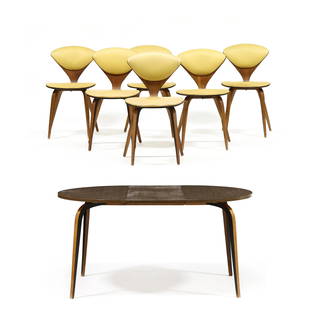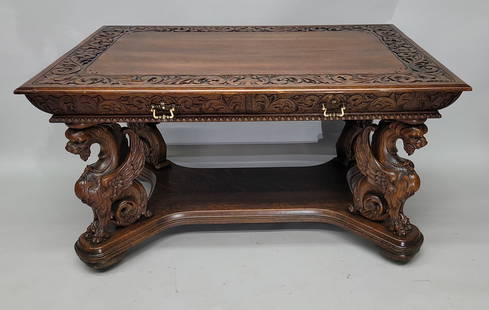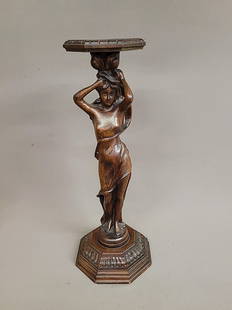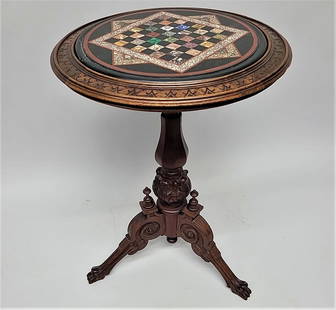
Ralph Eugene Cahoon, Jr (American, 1910-1982)
Similar Sale History
View More Items in Dining TablesRelated Dining Tables
More Items in American Dining Tables
View MoreRecommended Tables
View More



Item Details
Description
Ralph Eugene Cahoon, Jr (American, 1910-1982)
SHREVE'S WATCH SHOP, BOSTON
signed lower right ""R Cahoon""
oil on antique pocket watch shop sign on tin painting: 14 x 14 inches, overall 22 x 16 inches
Provenance: Wayne Pratt, Inc, Nantucket, Mass
Literature: For another example of a 19th Century Clock Maker's sign painted by Cahoon, please see "Mermaids and Air Balloons / The Whimsical Art of Ralph Cahoon" Heritage Plantation of Sandwich, Exhibition Catalogue May 10- October 25, 1987, cat. no. 34 "Fishing Scene"
Other Notes: Ralph Eugene Cahoon, Jr. was born in Chatham, Massachusetts on September 2, 1910, and the oldest child of Susan Mae Small and Ralph Eugene Cahoon. He spent his youth clamming, fishing and scalloping, developing a deep compassion and reverence for the sea, as well as earning him some money. His other favorite pastime was sketching, which was encouraged by his family and resulted in entering the School of Practical Art in Boston. Upon completion of his disciplined schooling, he returned to the Cape, met and married Martha Farham in 1932. Martha Farham, the daughter of Swedish immigrant parents, Alex and Elma Farham, was from Harwich and was a painter in her own right. Her father, Alex Farham, had been a painter for several decorating firms in Boston before he moved to Harwich and set up his own shop. Martha trained under her father learning the art of decorative painting called Rosemailing, a free-hand method using scrolls and flowers and early American stencil design. Ralph Cahoon learned these techniques as well by observing both Martha and her father in their studio.
In 1935, the Cahoons had their only child, Franz, and they moved to Osterville, Massachusetts and lived there for ten years decorating and selling furniture and antiques. They moved in 1945 to Santuit, a historic section of Cotuit, and this became their home, studio and shop until his death in 1982. He turned to easel painting full time in the 1950s and tried various surfaces to capture his primitive style of painting. He discovered that Swedish Masonite was the surface that most resembled the smooth, firm surface of furniture that best exhibited his technique of incorporating the use of stencils, the play of light and dark with combinations of bold colors and smooth brush strokes to give the feeling of a captured moment in time.
Cahoon used his childhood love of the sea and surroundings as inspiration for his whimsical and fantasy art incorporating shells, sailors, schooners, whales, nautical devices and his trademark mermaids. His vignettes of mermaids are often portrayed within a Cape Cod setting and his work is characterized by crisp delineation of form, a clear jewel-like spectrum of color and a self-assured attitude toward his subject. "There is effortlessness to the work, a magic in those brilliantly enameled surfaces-cheerfully, intentionally, ignorant of the laws of perspective..." (See Alexander Theroux, "Cape Cod's Elegant Primitive," Boston Magazine, 1986, pp.91-92).
Ralph Cahoon began to get noticed outside the Cape Code area when in 1953 he met Joan Whitney Payson, the art patroness. She saw his work and suggested that he frame them and send them to her to be sold at her Country Art Gallery in Westbury, Long Island. The paintings sold out immediately. He continued to show at her gallery until 1977 as well as galleries in Nantucket, Massachusetts; Hartford, Connecticut; Wilmington, Delaware; Neenah, Wisconsin; Carmel, California, Palm Beach, Florida and Nassau, Bahamas. In 1972, four of his paintings were sold by Hirschl & Adler Galleries, Inc., New York and a special exhibition of his work was shown in the same year at the Heritage Plantation celebrating the opening of its Arts and Crafts Building. In 1980 one of Cahoon's earlier cupboards was featured in an exhibition "Paint on Wood," at the Renwick Gallery, Smithsonian Institute which traced American decorated furniture from the 17th century to the present and the Heritage Plantation, Sandwich, Massachusetts, mount the "Travels with Mermaids" exhibition showing both Ralph and Martha Cahoon's paintings.
Ralph Cahoon died in February 1982 at the age of 72 after a long illness. In 1984, the Cahoon Museum of American Art was established in their home of 37 years and named in honor of the artist and his artist wife. The collection of the museum is highlighted by a number of works by both Ralph and Martha Cahoon.
Property of a New York Family
Estimate: $8,000-12,000
The owners of this fine collection were intent upon furnishing their gracious home with the best of 18th and 19th century American fine art, furniture and decorative arts. Their commitment to excellence can be seen in each piece they collected, striving for the finest in purity of form, materials and condition. The owners were adamant about knowing where or by whom a painting or piece of furniture was made; the pedigree had to match their rigorous criteria. The American furniture and decorative arts you will find on the following pages truly has global style and the pieces are certain to appeal to a wide audience of connoisseurs.
Just a few examples of the furniture that demonstrate the couple's commitment to their collecting approach include lot 89, a Rare Queen Anne Eight-Legged New York Mahogany Dining Table with its sculptural raised slipper feet. Lot 90, is a Diminutive Basket and Acanthus Leaf-Carved Salem, Massachusetts Sofa, and is a tour de force created by one of America's greatest craftsmen, Samuel McIntire (1711-1851) of Salem, Massachusetts. Lot 107 is an exceptional and beautifully crafted pair of Hartford, Connecticut Federal shield- back cherry wood side chairs that were formerly part of the Taradash Collection which was assembled and sold by Israel Sack Inc. ( Please see frontispiece of catalogue for detail of back). Lot 112 is a rare gilt and painted gallery wall timepiece; the dial and works are signed by the renowned clockmaker, Aaron Willard of Boston. Lot 118 is the Important Lansdell K. Christie Queen Anne Carved, Veneered and Gilt Walnut High Chest of Drawers, which was made in Boston circa 1740. This well-known example, exhibited at the Metropolitan Museum of Art in 1963, is a tour de force of Colonial Boston craftsmanship.
There is also a selection of high quality fine art being offered as well, including lots 24, the charming SMELT FISHERS, COS COB, 1902 and lot 32, the poetic and elegant SUNSET, ISLES OF SHOALS, 1904, both by Frederick Childe Hassam ( American, 1859-1935) . Lot 27 is a rare and clever collage by John Haberle (American, 1856-1933) THE ARTIST'S PALETTE. Lots 26 and 33 are works by Walter Launt Palmer (American, 1854-1932) which highlight his amazing ability to capture nature at its most moving and atmospheric times of the day, particularly at twilight.
The owners of this home relished life in well-appointed style and designed their rooms with vision that was both thoughtful and practical.
SHREVE'S WATCH SHOP, BOSTON
signed lower right ""R Cahoon""
oil on antique pocket watch shop sign on tin painting: 14 x 14 inches, overall 22 x 16 inches
Provenance: Wayne Pratt, Inc, Nantucket, Mass
Literature: For another example of a 19th Century Clock Maker's sign painted by Cahoon, please see "Mermaids and Air Balloons / The Whimsical Art of Ralph Cahoon" Heritage Plantation of Sandwich, Exhibition Catalogue May 10- October 25, 1987, cat. no. 34 "Fishing Scene"
Other Notes: Ralph Eugene Cahoon, Jr. was born in Chatham, Massachusetts on September 2, 1910, and the oldest child of Susan Mae Small and Ralph Eugene Cahoon. He spent his youth clamming, fishing and scalloping, developing a deep compassion and reverence for the sea, as well as earning him some money. His other favorite pastime was sketching, which was encouraged by his family and resulted in entering the School of Practical Art in Boston. Upon completion of his disciplined schooling, he returned to the Cape, met and married Martha Farham in 1932. Martha Farham, the daughter of Swedish immigrant parents, Alex and Elma Farham, was from Harwich and was a painter in her own right. Her father, Alex Farham, had been a painter for several decorating firms in Boston before he moved to Harwich and set up his own shop. Martha trained under her father learning the art of decorative painting called Rosemailing, a free-hand method using scrolls and flowers and early American stencil design. Ralph Cahoon learned these techniques as well by observing both Martha and her father in their studio.
In 1935, the Cahoons had their only child, Franz, and they moved to Osterville, Massachusetts and lived there for ten years decorating and selling furniture and antiques. They moved in 1945 to Santuit, a historic section of Cotuit, and this became their home, studio and shop until his death in 1982. He turned to easel painting full time in the 1950s and tried various surfaces to capture his primitive style of painting. He discovered that Swedish Masonite was the surface that most resembled the smooth, firm surface of furniture that best exhibited his technique of incorporating the use of stencils, the play of light and dark with combinations of bold colors and smooth brush strokes to give the feeling of a captured moment in time.
Cahoon used his childhood love of the sea and surroundings as inspiration for his whimsical and fantasy art incorporating shells, sailors, schooners, whales, nautical devices and his trademark mermaids. His vignettes of mermaids are often portrayed within a Cape Cod setting and his work is characterized by crisp delineation of form, a clear jewel-like spectrum of color and a self-assured attitude toward his subject. "There is effortlessness to the work, a magic in those brilliantly enameled surfaces-cheerfully, intentionally, ignorant of the laws of perspective..." (See Alexander Theroux, "Cape Cod's Elegant Primitive," Boston Magazine, 1986, pp.91-92).
Ralph Cahoon began to get noticed outside the Cape Code area when in 1953 he met Joan Whitney Payson, the art patroness. She saw his work and suggested that he frame them and send them to her to be sold at her Country Art Gallery in Westbury, Long Island. The paintings sold out immediately. He continued to show at her gallery until 1977 as well as galleries in Nantucket, Massachusetts; Hartford, Connecticut; Wilmington, Delaware; Neenah, Wisconsin; Carmel, California, Palm Beach, Florida and Nassau, Bahamas. In 1972, four of his paintings were sold by Hirschl & Adler Galleries, Inc., New York and a special exhibition of his work was shown in the same year at the Heritage Plantation celebrating the opening of its Arts and Crafts Building. In 1980 one of Cahoon's earlier cupboards was featured in an exhibition "Paint on Wood," at the Renwick Gallery, Smithsonian Institute which traced American decorated furniture from the 17th century to the present and the Heritage Plantation, Sandwich, Massachusetts, mount the "Travels with Mermaids" exhibition showing both Ralph and Martha Cahoon's paintings.
Ralph Cahoon died in February 1982 at the age of 72 after a long illness. In 1984, the Cahoon Museum of American Art was established in their home of 37 years and named in honor of the artist and his artist wife. The collection of the museum is highlighted by a number of works by both Ralph and Martha Cahoon.
Property of a New York Family
Estimate: $8,000-12,000
The owners of this fine collection were intent upon furnishing their gracious home with the best of 18th and 19th century American fine art, furniture and decorative arts. Their commitment to excellence can be seen in each piece they collected, striving for the finest in purity of form, materials and condition. The owners were adamant about knowing where or by whom a painting or piece of furniture was made; the pedigree had to match their rigorous criteria. The American furniture and decorative arts you will find on the following pages truly has global style and the pieces are certain to appeal to a wide audience of connoisseurs.
Just a few examples of the furniture that demonstrate the couple's commitment to their collecting approach include lot 89, a Rare Queen Anne Eight-Legged New York Mahogany Dining Table with its sculptural raised slipper feet. Lot 90, is a Diminutive Basket and Acanthus Leaf-Carved Salem, Massachusetts Sofa, and is a tour de force created by one of America's greatest craftsmen, Samuel McIntire (1711-1851) of Salem, Massachusetts. Lot 107 is an exceptional and beautifully crafted pair of Hartford, Connecticut Federal shield- back cherry wood side chairs that were formerly part of the Taradash Collection which was assembled and sold by Israel Sack Inc. ( Please see frontispiece of catalogue for detail of back). Lot 112 is a rare gilt and painted gallery wall timepiece; the dial and works are signed by the renowned clockmaker, Aaron Willard of Boston. Lot 118 is the Important Lansdell K. Christie Queen Anne Carved, Veneered and Gilt Walnut High Chest of Drawers, which was made in Boston circa 1740. This well-known example, exhibited at the Metropolitan Museum of Art in 1963, is a tour de force of Colonial Boston craftsmanship.
There is also a selection of high quality fine art being offered as well, including lots 24, the charming SMELT FISHERS, COS COB, 1902 and lot 32, the poetic and elegant SUNSET, ISLES OF SHOALS, 1904, both by Frederick Childe Hassam ( American, 1859-1935) . Lot 27 is a rare and clever collage by John Haberle (American, 1856-1933) THE ARTIST'S PALETTE. Lots 26 and 33 are works by Walter Launt Palmer (American, 1854-1932) which highlight his amazing ability to capture nature at its most moving and atmospheric times of the day, particularly at twilight.
The owners of this home relished life in well-appointed style and designed their rooms with vision that was both thoughtful and practical.
Buyer's Premium
- 24%
Ralph Eugene Cahoon, Jr (American, 1910-1982)
Estimate $8,000 - $12,000
5 bidders are watching this item.
Shipping & Pickup Options
Item located in New York City, New York, usSee Policy for Shipping
Payment

TOP





































































